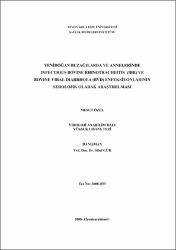Yenidoğan Buzağılarda ve Annelerinde Infectıous Bovıne Rhınotracheıtıs (Ibr) ve Bovıne Vıral Dıarrhoea (Bvd) Enfeksiyonlarının Serolojik Olarak Araştırılması
Özet
Bu çalısmada, Afyonkarahisar ilinde Bovine Viral Diarrhoea Virus (BVDV)
ve Bovine Herpesvirus type 1 (BHV1) enfeksiyonlarının insidenslerinin
arastırılması amaçlandı. Toplam 162 inek ve prekostral yavruları örneklendi,
organize sürülerden örneklenen ineklerin sayısı 155 iken aile tipi isletmelerden 7
inek kullanıldı. Toplam 324 serum Virus Nötralizasyon test ile kontrol edildi.
Organize sürülerdeki sığırlarda BVDV spesifik antikor oranlarının %77.7 ile
%100 arasında değiºtiği ve aile tipi çiftliklerde %57.1 değeri belirlendi. Sürü 1’de
tüm yavruların negative olduğu tespit edildi, diğer organize sürülerde %10 (3/30)
ve %14.6 (17/116) oranları belirlendi. Danalardaki en yüksek oran aile tipi
iºlermelerde %28.5 olarak tespit edildi. Toplam olarak 162 ineğin 155’inin
(%95.6) ve 22 dananın (%13.5) BVDV seropozitif olduğu saptandı.
BHV1 antikor oranları sığırlarda %69.7 (113/162) olarak belirlenirken sürü
3’de sadece 1 dana seropozitif olarak bulundu. Üç organize sürüdeki sığırlardaki
seropozitiflik oranlarının %66.6 (6/9) ile %73.3 (22/30) arasında değiºtiği ancak
aile tipi çiftliklerde bu oranın %42.8 (3/7) olduğu saptandı.
Bu çalısmada, elde edilen tüm değerlerin doğal enfeksiyona bağlı olduğu
sonucuna varıldı. Örneklenen 162 dananın 22 ve 1’i sırasıyla BVDV ve BHV1
için antikor pozitif olarak bulundu. Açıktır ki fötuslar immun yeterlilik
kazandıktan sonra enfekte olmuslardır ve çalısılan her iki virus da sürülerin
çoğunda sirkulasyondadır. In this study, to investigate the incidence of Bovine Viral Diarrhoea Virus
(BVDV) and Bovine Herpesvirus type 1 (BHV1) infections in Afyonkarahisar
province was aimed. Total of 162 cows and their calves in precolostral period
were sampled, the number of sampled cows from three organised herd was 155
and 7 cows was used from family type small enterprises. Total of 324 sera were
controlled using Virus Neutralization Test.
BVDV specific antibody proportion was determined among 77.7% and
100.0% in cattle organised herd, and 57.1% value detected in family type farms.
The all calves were found to be negative in herd one, in other organised herds
10% (3/30) and 14.6% (17/116) proportions were determined. The highest rate in
calves was observed in family type farms as 28.5%. In total out of 162 cows 155
(95.6%) and 22 calves (13.5%) were found to be seropositive for BVDV.
BHV1 antibody proportions in cows were detected as 69.7% (113/162) in
cows while only a calf was seropositive in herd 3. In three organisated herd,
seropositivity values in cows were between 66.6% (6/9) and 73.3% (22/30),
however, in family type farms, this rate was determined 42.8% (3/7).
In this study, it was concluded that, all of the obtained values were result of
natural infection. Out of 162 sampled calves, 22 and 1 precolostral calves were
detected as antibody positive for BVDV and BHV1, respectively. It is obvious
that foetuses were infected after gaining the immune competence and both studied
viruses were in the circulation in most of the herds.
Bağlantı
http://hdl.handle.net/11630/3555Koleksiyonlar
- Yüksek Lisans Tezleri [635]



















